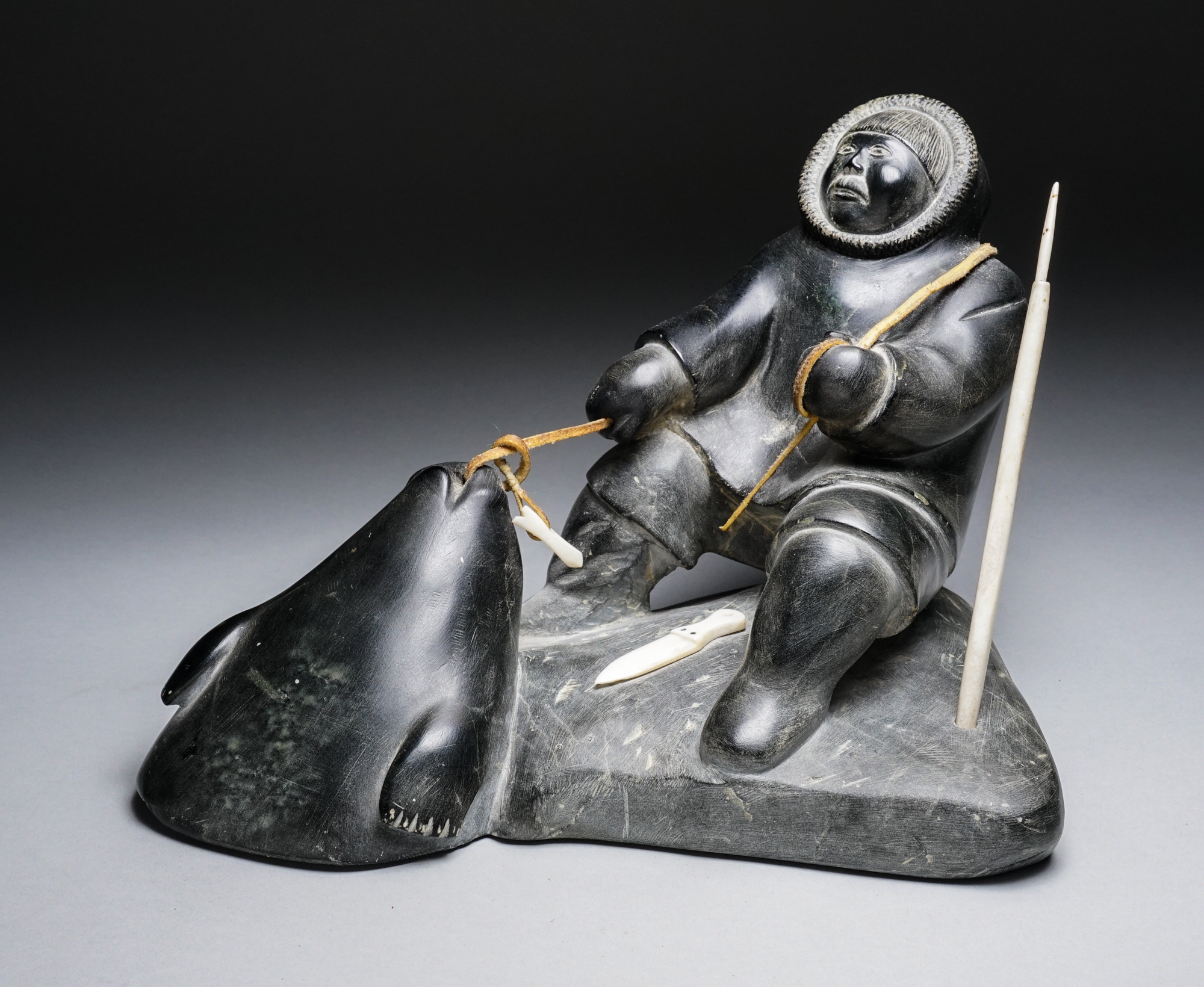
Simonee Aupaluktuq, HUNTER PULLING SEAL, stone, skin, ivory, antler, 6 1/2 x 10 1/4 x 6 1/2 in.
“We have the right to hunt. We have the right to use renewable resources to feed our families. We have the right to survive.” – Tanya Tagaq [1]
Seal hunting has been an important part of Inuit lifeways for centuries. A deeply rooted cultural practice, it provides an essential source of country food for communities in the North, and has been a primary material used for garments and tents. Depictions of the seal hunt are prevalent in Inuit art – from the earliest prints of 1959 to the contemporary large-scale drawings by hunter/artist Quvianaqtuk Pudlat; and across all media, from drawing to sculpture.
In the North, Inuit hunt several species of seals, including the harp seal, ringed seal, and bearded seal. The hunt takes place in the Spring when the seals come up to the surface of the ice to breathe. The entire animal is used for food, clothing, and other essential purposes.
The frigid climate and permafrost means that growing fruits and vegetables is not an option in the North, and imported produce from the south goes for exorbitant prices. “Seal very much happen to be the daily bread of Arctic dwellers,” says Karla Jessen Williamson, a professor at the University of Saskatchewan. [2]
Controversy
Seal hunting has garnered attention for many years as a controversial practice, criticized by animal rights activists and anti-sealing groups around the world. In 2018, the documentary Angry Inuk directed by filmmaker Alethea Arnaquq-Baril highlighted the decades-long controversy. The film documents the efforts of young Inuk hunters who leverage social media to challenge the perspectives of anti-seal hunting activists. Efforts to highlight the importance of the tradition to Inuit culture and lifeways continue to this day.
Seal hunting is a complex issue that raises important questions about the balance between long-standing cultural traditions and debates over animal welfare. Inuit advocates stress that the practice is necessary for their survival and should be allowed to continue, while animal rights groups argue against them.
An Essential Lifeway
Although Inuit, along with other Indigenous communities, only hunt for what is needed rather than what one wants, seal hunting is still heavily regulated by the Canadian government. This includes annual quotas intended to ensure the hunt remains sustainable and does not threaten the long-term survival of the species. [3]
The North remains the most food insecure region in any developed country, yet still faces issues of poverty and discrimination when sourcing essential food via traditional means, largely from organizations far away from the communities in question. [4] Despite government regulations, seal hunting remains a highly contentious issue. Regardless, seal hunting is a vital part of Inuit culture and way of life; it is crucial for Arctic communities to preserve their traditions and their connection to the land and what it provides.
To view available artworks of seal hunting, click here.
Sources:
[1] Tanya Tagaq in Selena Randhawa, “Animal rights activists and Inuit clash over Canada’s Indigenous food traditions,” The Guardian (2017)[2] Danny Kerslake, “Importance of seal hunt to the Inuit is focus of documentary screening,” panel in Saskatoon. CBC News. Mar 01, 2018.
[3] Aaju Peter in Selena Randhawa, “Animal rights activists and Inuit clash over Canada’s Indigenous food traditions,” The Guardian (2017)
[4] Ibid.
